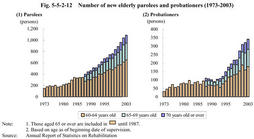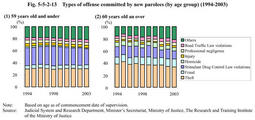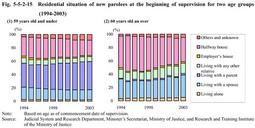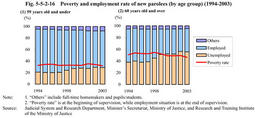| Previous Next Index Image Index Year Selection | |
|
|
2. Elderly parolees and probationers Elderly parolees/probationers have been on the rise similarly to inmates in prisons.This section describes mostly elderly parolees."Elderly"is defined as those aged60and figures for those aged65or over are stated if necessary.
(1) Elderly parolees/probationers newly placed under supervision Fig. 5-5-2-12(1) shows the number of new elderly parolees since1973.Those parolees aged 60 or over jumped from150or0.9%in1973to1,088or6.9%(Those aged65or over were437or2.8%)in2003.The elderly percentage in new parolees was lower than that in new prisoners or in prisoners imprisoned at the end of the year(respectively9.3%and11.0%in2003).This is because older prisoners are less likely to be released on parole(see this part, Chapter3,Section2,2,(4) ).
Fig. 5-5-2-12(2) shows the number of new elderly probationers since1973.Those probationers aged60or over jumped from32or0.4%in1973to341or6.3%(Those aged65or over were162or3.0%)in2003. Fig. 5-5-2-12 Number of new elderly parolees and probationers(1973-2003) (2) Type of offence Fig. 5-5-2-13 shows a breakdown of new parolees by type of offense for two age groups(aged 60 or over and 59 or under)in the past10years.
The respective percentages of theft and fraud are higher among elderly parolees than among younger ones.The difference,however,is not so noticeable as is the case with new prisoners(see Fig. 5-3-2-16 ).The proportion of homicide is also higher among elderly parolees than among younger ones.This is because homicide percentage is high among new elderly prisoners( Chapter3,Section2,2,(2)A) and also because those imprisoned for a long time for homicide had been released on parole after their reaching60. On the other hand,the proportion of stimulant drug offense is lower among the elderly than among the younger. Fig. 5-5-2-13 Types of offense committed by new parolees(by age group)(1994-2003) (3) Frequency of imprisonment Fig. 5-5-2-14 shows a breakdown of new parolees by frequency of imprisonment for two age groups(aged60or over and59or under).Imprisonment time is larger among elderly parolees than among younger ones.In particular,the percentage of those who have been imprisoned six times or more is much higher among elderly parolees.
Fig. 5-5-2-14 Frequency of imprisonment of new parolees(by age group)(1994-2003) (4) Residential situation Fig. 5-5-2-15 shows a breakdown of new parolees by residential situation at the beginning of supervision for two age groups(aged60or over and59or under).The percentage of elderly parolees living with their parents was very low,while that of those living in halfway houses was high.This indicates that old parolees'residential situations are poorer than those of younger ones.It should be remembered that the figure compares only between old and younger parolees and that many elderly prisoners are not released on parole because they have no place to return from prisons(see this part, Chapter3,Section2,2,(4) ).
Fig. 5-5-2-15 Residential situation of new parolees at the beginning of supervision for two age groups(1994-2003) (5) Poverty and employment rate Fig. 5-5-2-16(1) shows the poverty rate of parolees at the beginning of supervision and employment of parolees at the end of supervision for two age groups(aged60or over and59or under).
Poverty rate was higher among elderly parolees than among younger ones.Furthermore,unemployed percentage at the end of supervision was also high.These figures indicate that elderly parolees are economically unstable due to their bleak employment situation. Fig. 5-5-2-16 Poverty and employment rate of new parolees(by age group)(1994-2003) (6) Supervision and treatment for elderly parolees and probationers There are various types of elderly parolees and probationers.Some have been repeating a number of offenses since their youth.Some others committed serious offenses,spent a long time in prison,and finally were released on parole(for long-term parolees,see Section4 ).Some of them are difficult to treat in parole/probation supervision.An offender's rehabilitation in society,in general,means that he/she establishes an independent and stable life and reassumes his/her roles as a citizen.For this goal,it is essential for an offender to secure employment.In the case of elderly parolees/probationers,however,they have to face an unfavorable employment situation.Moreover,an"independent life"is a goal too difficult for them to pursue because of their problems associated with old age.
For those who cannot live independently,it is the most important measure to help them receive public welfare services such as welfare benefits or nursing-care insurance benefits.There are,however,practical problems for them to receive those measures.For example,those with no fixed address can not apply for welfare benefits. Elderly parolees and probationers will continue to rise with the aging of offenders and prisoners.The Rehabilitation Bureau of the Ministry of Justice created a new category called"elderly(aged65or over)parolees and probationers"for the categorized treatment system in April2003.In addition to the efforts to enhance effective treatment and supervision for elderly parolees and probationers,further cooperation with the organizations in medical and welfare services is indispensable in order to prevent them from repeating offenses. |




